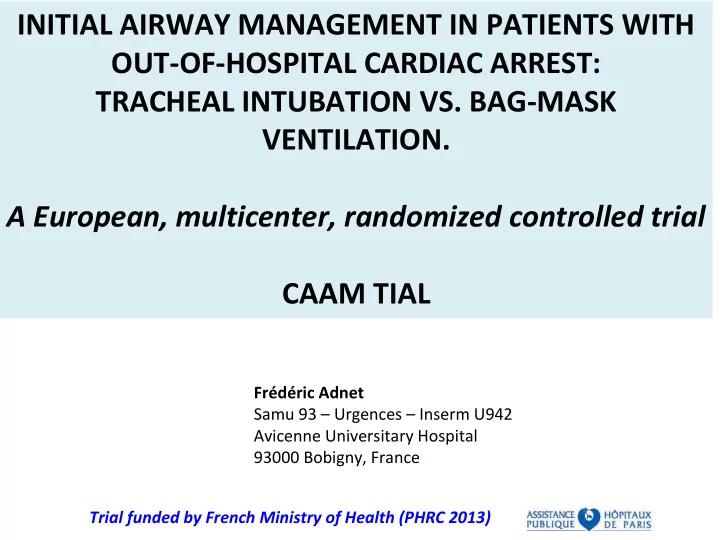

INITIAL AIRWAY MANAGEMENT IN PATIENTS WITH OUT-OF-HOSPITAL CARDIAC ARREST: TRACHEAL INTUBATION VS. BAG-MASK VENTILATION. A European, multicenter, randomized controlled trial CAAM TIAL Frédéric Adnet Samu 93 – Urgences – Inserm U942 Avicenne Universitary Hospital 93000 Bobigny, France Trial funded by French Ministry of Health (PHRC 2013) BVM vs. Intubation in OHCA patients: CAAM Trial
Rationale • Benefit of endotracheal intubation (ETI) during CPR is unclear. • Observational studies suggest Bag-Mask ventilation (BMV) is associated with better survival than ETI • Quasi-randomized trial in children suggested no significant difference in survival or neurologic outcome with ETI vs. BMV
Hypothesis • Bag-Mask Ventilation (BMV) is less complex technique than ETI, appears to be safe and may avoid adverse effects of tracheal intubation (ETI) during CPR • We conducted a non-inferiority, multicenter, randomized controlled trial of BMV versus ETI.
Design • Primary Outcome: survival to 28 days with good neurological outcome. • Secondary outcomes included ROSC, survival at hospital admission, adverse effects. • 1000 patients per arm is required to have 80% power to demonstrate non-inferiority with margin fixed at 1%.
Study Setting: 20 pre-hospital emergency medical services centers (SAMU): 15 in France and 5 in Belgium
Baseline Characteristics (ITT population = 2040) ballet.alain@neuf.fr BMV group ETI group Characteristics (N=1018) (N=1022) 65.7±15.5 63.8±15.6 Age – yr, mean ±SD 332 (32.6) 332 (32.5) Female gender – no. (%) 776 (76.2) 811 (79.4) Arrest occurring at home – no. (%) 719 (70.6) 708 (69.3) Bystander witnessed – no. (%) 168 (16.5) 155 (15.2) Shockable first rhythm – no. (%) 3 (1, 7) 3 (1, 6) Number of shocks – median (interquartile range)
Primary outcome (ITT analysis) Primary outcome BMV ETI Difference [95% CI] (N=1018) (N=1022) Survival with good neurological status at day 28 N= 42 (4.2%) N= 43 (4.3%) 0.11 [-1.64; 1.87] 0 1% BVM group Intubation group better better
Outcomes (ITT analysis) BMV ETI group P Outcomes group (N=1022) value (N=1018) Return of spontaneous circulation – no. (%) 348 (34.2) 397 (38.9) 0.03 Survival at hospital admission– no. (%) 294 (28.9) 333 (32.6) 0.07 55 (5.4) 54 (5.3) 0.90 Survival at day 28 – no. (%)
Safety analysis Item BMV group ETI group p (N=1028) (N=1001) BMV or ETI failure – no. (%) 64 (6.3) 26 (2.5) <0.0001 BMV or ETI difficulty – no. (%) 186 (18.1) 134 (13.4) 0.004 Regurgitation of gastric content 152 (14.9) 79 (7.7) <0.0001
Conclusion • Our trial was inconclusive regarding the demonstration of non-inferiority of BMV compared with TI for airway management during CPR in OHCA patients • However, this randomized study did not confirm superiority of BMV reported in observational studies • On the other hand, BMV is associated with increased complications and difficulty.
Recommend
More recommend